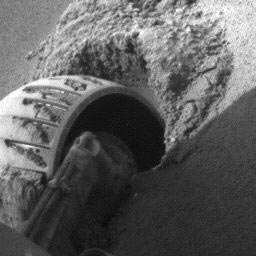

Teacher in Space Project
Teacher in Space Project Christa McAuliffe (left) and Barbara Morgan pose in front of the Space Shuttle mission simulator (SMS) after their selection for TISP. The Teacher in Space Project (TISP) is a NASA program designed to educate students and spur excitement in math, science, and space exploration. Christa McAuliffe was selected to be the first teacher in space in 1984 with Barbara Morgan as her alternate. McAuliffe died during the launch of the 25th Space Shuttle mission, STS-51-L, which was to make her the first teacher in space. NASA halted the TISP until 1998 amid concerns surrounding the risk of sending civillians to space. Morgan was selected as the first Educator Astronaut in January, 1998. Morgan is assigned to the crew of STS-118 which may launch
Image : Opportunity's left front wheel. Image credit: NASA/JPL.

NASA's Rovers Continue Martian Missions 05.24.05 -- NASA's Mars rover Opportunity is trying to escape from a sand trap, while its twin, Spirit, has been busy finding new clues to a wet and violent early Martian history.
The shuttle program was launched on January 5, 1972, when President Richard M. Nixon announced that NASA would proceed with the development of a reusable low cost space shuttle system. The project was already to take longer than originally anticipated due to the year-to-year funding caps. Nevertheless work started quickly and several test articles were available within a few years. Most notable among these was the first complete Orbiter, originally to be known as Constitution. However a massive write-in campaign on the part of fans of the TV show Star Trek convinced the White House to change the name to Enterprise. Enterprise was rolled out on September 17, 1976 and later conducted a very successful series of landing tests which was the first real validation of the gliding abilities of the design. The first fully functional shuttle orbiter was the Columbia, which was delivered to Kennedy Space Center on March 25, 1979 and was first launched on April 12, 1981 with a crew of two. Challenger was delivered to KSC in July 1982, Discovery was delivered in November 1983, and Atlantis was delivered in April 1985. Challenger was destroyed in an explosion during launch in January 1986 with the loss of all seven astronauts on board, and Endeavour was built as a replacement (using spare parts originally built for the other orbiters) and delivered in May 1991. Columbia was lost, with all seven crew, in a re-entry mishap on February 1, 2003.
Space Shuttle ChallengerShuttle development
Space Shuttle Challenger Shuttle Orbiter Challenger (NASA Designation: OV-99) was a Space Shuttle orbiter. Challenger was the second shuttle orbiter to be placed into service (after Columbia) and was constructed using a body frame (STA-099) that had initially been produced for use as a test article. Its maiden voyage was on April 4, 1983, and made eight subsequent round trips to low earth orbit before it was destroyed during launch for its tenth mission, mission 51-L. Table of contents showTocToggle("show","hide") 1 Flights 2 Flight Log 3 Related articles 4